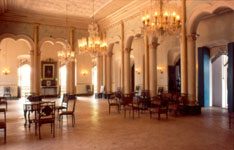Some houses take you by surprise or by storm. If you were there, you will meet Rajendra and his family who occupy the north wing of the house and have the Chapel, the courtyard, two large bedrooms and a corridor under their care. Then you will meet Mick, the interior decorator and Alice, his charming wife and see how they have treasured all the priceless pieces of the house to be recycled in time. You meet Dr Max in what was once the dining hall of the large house and is now the formal drawing room and you go over the history of the Loyola-Furtado house at Chinchinim. Between 1790 and 1800, “Morgad” José Maria Furtado built a palatial mansion over the land that was once the temple tank. Perhaps it was not the same house that we see today but there is no doubt that it was the house of an important and influential member of the Chinchinim village community. By the time “Morgad” José Maria Furtado raised his young family, wealth from the coconut, areca nut, paddy and fish enabled him to rebuild the old house into the palacio we see today. Like most houses in Goa this one too has a central axis.
Fourteen steps lead you into the entrada. A frangipani tree in full blor the smaller visitor’s room. Beside the saleta, a passage converted to a guest room and a bathroom with modern plumbing added on to the main room greets you with a formal nodding of its pink leafless blossoms. Inside, you have stepped on to flooring that has been discreetly relaid in recent years by Mick and Alice who have opened up the plinth from within to make a basement-bedroom for themselves. Behind entrada and the saleta house, the outhouses, storerooms, firewood sheds and grain stores girdled the back of the house once. Painting the ceiling and the walls was the ideal, the ultimate fashion statement, and a discreet alternative. In the sala, a flooring of white and black flowers strewn and elsewhere, under your feet, wooden floorboards creak as you walk out to the two rooms adjoining the sala. Today, the courtyard stays undefined, a shapeless mass of land with a few odd trees.
When the house was divided to accomodate all the members of the family, the ornamental windows had to be torn down and wall partitions created for privacy. Instead of a blank wall partition, doors and windows have been painted on to the plaster. So like Duryodhana in the Epic, you too find yourself walking into a wall or trying to open a window that does not exist. Today, Dr Max has to live up to the historic legacy of Dr José ínacio de Loyola and to the high standards of hospitality as set by his forefathers for this house he has inherited. It is a house where both the poor and the privileged received moral support, medical aid and material succour. The voices that once filled the sala with Ave Maria’s have left but if you hold your ear close to the walls, each 6 feet deep, you can hear the faint strains of the hymn.


